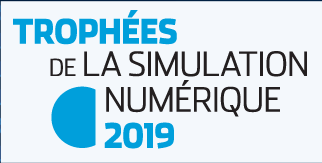ESI Group wins the Innovation prize of ‘L’Usine Digitale Trophies for Simulation and Digital Technologies’ along with the ‘audience award’ for its innovative concept: the Hybrid Twin™

Yesterday, Tuesday June 11, the ESI Group, leader and pioneer of virtual prototyping industrial solutions, was awarded the 2019 prize of ‘L’Usine Digitale Trophies for Simulation and Digital Technologies’, in the ”Innovation” category, along with the ‘audience award’ for its Hybrid Twin™. The prizes were presented to Alain de Rouvray, Founder and Chairman of ESI Group, at the TERATEC Forum, the meeting of international experts in the field of Simulation and Big Data.
The common digital simulation models, referred to as ‘Digital Twins’, are currently meant to predict and drive the behavior of industrial products in Service. However, they are built out of data from past events and based on patterns empirically derived from similar products under similar circumstances. They are not efficiently enriched by elements identified in real time on a given product, and do not adapt to random or unencountered occurrences, as will typically result from innovative design, new materials and processes, or new operating conditions. They lack the ability to account for unpredictable factors not identified during the regulatory certification, such as specific product aging due to wear and tear and moment by moment changes in the environmental operational conditions.
ESI’s Hybrid Twin™ aims to resolve these challenges of specific and predictable product performance and piloting in-Service. Through the use of model reduction algorithms based on PGD (Proper Generalized Decomposition), and by combining detailed virtual prototypes, integrating all ESI’s historical physics-based materials science and knowledge, with an enhanced digital twin (based on the IoT data), ESI Group has created a concept and disruptive industrial solutions enabling numerical simulations of products in-Service, and making predictive maintenance reliably actionable. The Hybrid Twin™ uses virtual prototypes enriched with real data and exploits A.I. and Machine Learning to make more accurate predictions possible and practical. The Hybrid Twin™ monitors system changes in real time and offers the possibility to accurately predict individual product specific behavior. Taking two real examples, the Hybrid Twin™ means an average reduction of 30 % in the maintenance and monitoring costs of a wind farm or reducing down time and maintenance costs of helicopter systems.
Alain de Rouvray, Chairman of the ESI Group, states: ‘Discovery and innovation do accelerate when experience and intuition are strengthened by rational prediction. This is where ESI’s Hybrid Twin™ comes in, ‘hybridizing’ the best of both worlds: The causal theoretical models of the ‘as built’ and certified virtual prototype, and the empirical information continuously gained from the actual product in operation. In a world seeking ever more personalization, the Hybrid Twin™ offers a solution for manufacturers by bringing together prediction, personalization and knowledge derived from proven physics and available data. Beyond certification of the brand-new product, prediction of the performance in-Service of the used, aged and repaired product, now occupies a central position among the major engineering challenges of Industry 4.0 and of the ‘Outcome’ economy focusing on continuous results in actual operation. The real-time model optimization offered by ESI’s Hybrid Twin™ ushers the new era of the physics based ‘Product Performance Lifecycle’ (PPL™ ), taking the incumbent paradigm of the CAD based ‘Product Lifecycle Management’ (PLM) to the next era, i.e. to the monitoring and piloting of the real product in its real life, from launch to maintenance and safe retirement. We are indeed very proud to receive this coveted Innovation prize along with the ‘audience award’, both rewarding the work of all our engineers, personnel and partners who, for over 45 years, have supported industry manufacturers wishing to improve and accelerate the understanding and performance of their products for ever increasing economic social benefits!’.